Abstract
The rise in atmospheric CO2 intensified the urgency for carbon capture and storage (CCS), yet uncertainties remain in predicting evolution of reservoir properties under CO2 injection. This study investigates how CO2–brine–rock interactions alter porosity and permeability in carbonate and sandstone reservoirs. We quantify pore-scale changes and effects of CO2-saturated brine on rock. In calcite-rich carbonates, CO2-induced acidification enhances permeability through selective dissolution. Dolomite-rich samples and sandstones exhibit suppressed permeability response due to slower dissolution and pore clogging. μCT and SEM reveal that although bulk porosity changes are small, local changes—especially formation of micropores and mineral occlusions—substantially influence permeability. Geochemical modeling confirms three-stage evolution: early dissolution, intermediate buffering with onset of precipitation, and long-term mineral trapping with near-steady porosity. The results indicate that early injectivity gains may be temporary and that proactive monitoring and management are required to safeguard long-term storage integrity. The findings provide actionable insight for sustainable CCS design, risk assessment, and reservoir stewardship.
1. Introduction
The rise in atmospheric CO2 has driven global warming beyond safe thresholds. Carbon capture and storage (CCS) is now widely recognized as a critical climate mitigation strategy, with recent analyses showing CCS deployment must scale up dramatically to meet Paris targets. For example, Kazlou et al. [1] note that climate mitigation “requires the large-scale deployment of carbon capture and storage (CCS)” and point out plans for an eight-fold increase in CCS capacity by 2030. Similarly, Kelemen et al. [2] emphasize that to limit warming to 1.5–2 °C, “it will be essential to permanently sequester about 10 billion tons of CO2 per year by mid-century”. Geological storage of CO2 in deep saline aquifers or depleted reservoirs—including both sandstone and carbonate formations—is among the most mature and attractive options. However, injection of CO2 acidifies formation water and triggers complex water–rock reactions that can alter reservoir integrity and storage capacity. These alterations may affect porosity, permeability, and fracture networks, with implications for injectivity and long-term containment. Thus, there is urgent need to understand CO2–brine–rock interactions under realistic conditions as part of CCS research.
When CO2 dissolves into formation water under reservoir conditions, it forms carbonic acid, which decreases fluid pH and promotes mineral dissolution reactions, especially in carbonate-rich lithologies. Carbonate dissolution can enhance porosity and permeability near injection wells, improving injectivity but potentially increasing leakage risk if faults or fractures are reactivated [3]. Conversely, the precipitation of carbonate or silicate minerals, either as secondary cements or as pore-filling phases, can reduce pore connectivity and impair injectivity [4]. Silicate minerals such as feldspars and clays may dissolve slowly, consuming acidity and releasing silica and trace elements that can precipitate as secondary phases downstream. These coupled processes control both the evolution of reservoir flow properties and the long-term immobilization of CO2 through mineral trapping mechanisms.
Laboratory studies using core-scale autoclave experiments have provided valuable insights into short-term rock–brine–CO2 interactions under controlled pressure–temperature conditions [5]. For example, Tale et al. [6] reported significant calcite dissolution and permeability increases by a factor of two in limestone samples exposed to CO2-saturated brine at 150 °F over several weeks. In contrast, sandstone cores with quartz and feldspar matrices exhibited only minor porosity changes but demonstrated aluminosilicate dissolution and clay mineral alteration [7]. Recent micro-computed tomography (μCT) and scanning electron microscopy (SEM) analyses have enabled three-dimensional visualization of pore network evolution, revealing heterogeneous dissolution patterns and the formation of preferential flow paths [8].
Geochemical modeling has emerged as a powerful tool to extrapolate laboratory observations to field-scale scenarios and longer timescales. However, model reliability strongly depends on accurate kinetic rate laws, reactive surface area estimates, and the representation of pore-scale heterogeneity [9,10].
Despite extensive study, fundamental uncertainties remain at the pore to reservoir scale. First, the pore-scale mechanisms by which CO2-charged brines alter rock microstructure are not well-characterized [8]. Dissolution of reactive minerals (e.g., calcite) can enlarge pores, but precipitation of secondary phases or mobilization of fines can clog flow paths. Seyyedi et al. [11] note that the impact of CO2–brine–rock interaction on pore structure and flow is “poorly characterized” even in near-wellbore regions. The interplay of dissolution, precipitation, and particle transport at the pore scale, and how these processes couple to mechanical stresses, remains especially unclear. Second, upscaling laboratory findings to field conditions is challenging. Laboratory core tests probe centimeters to decimeters and days to months, whereas actual reservoirs span kilometers and evolve over decades. This scale gap can introduce large uncertainties in predicting reservoir evolution. For example, Ferreira et al. [12] highlight that the sample volumes imaged by micro-CT are orders of magnitude smaller than those tested in petrophysical experiments, complicating direct comparison of porosity/permeability. Similarly, Kelemen et al. (2019) [2] emphasize the need to understand processes from the nano- to kilometer scale. Laboratory conditions (flow rates, chemistry, or P–T) often differ from in situ values, so translating pore-scale observations to reservoir performance remains an open problem. Third, comparative lithology studies are scarce. Carbonate and sandstone reservoirs host very different mineralogy and pore networks—carbonates often containing abundant calcite–dolomite, and sandstones dominated by quartz and clays—so reaction patterns may differ qualitatively. However, most experiments have focused on a single rock type, making it hard to disentangle lithology effects. Controlled experiments across lithologies with standardized brine chemistry are needed to isolate how mineralogy and pore structure control reactivity and flow changes.
This work aims to fill these gaps through a systematic, quantitative experimental study with imaging and modeling. The specific objectives are as follows:
- Porosity and permeability changes: Quantify how long-term CO2-saturated brine exposure affects porosity and permeability in carbonate and sandstone cores. We will measure the pre- and post-experiment reservoir properties under high P–T conditions.
- Pore-scale alteration: Use scanning electron microscopy (SEM) and X-ray micro-computed tomography (μCT) to characterize mineral dissolution/precipitation and pore-network evolution in the reacted cores.
- Kinetic reaction modeling: Develop site-specific simulations to interpret experimental results and extend them to field-relevant scales. We employed The Geochemist’s Workbench (GWB) to simulate the experiments and predict long-term reservoir behavior.
These objectives directly address the need to characterize pore-scale evolution under realistic conditions and enable more reliable upscaling.
Importantly, the processes we study have clear sustainability implications. The permanence and predictability of subsurface CO2 storage, which are central to achieving greenhouse gas mitigation targets, depend directly on how pore networks and mineral phases evolve after injection. Transient gains in injectivity, long-term pore occlusion, or unexpected changes in permeability affect not only technical performance (e.g., required injection pressures, monitoring intensity, and remediation needs) but also the economics, lifecycle greenhouse gas accounting, environmental risk to overlying freshwater resources, and the social license to operate CCS projects. Improved mechanistic understanding, therefore, supports better risk assessment, cost-effective monitoring strategies, and evidence-based regulatory frameworks, all of which are necessary for CCS to contribute sustainably and responsibly to climate mitigation portfolios.
The proposed study is innovative due to its integrated, multi-scale approach. First, we conducted long-term high-pressure and high-temperature autoclave experiments on whole core samples from a set of eight carbonate and two Cambrian sandstone cores from Polish hydrocarbon fields, combining flow-through exposures with comprehensive pre- and post-test petrophysical characterization. Very few studies have combined extended high-P/T core-flooding with detailed geochemical imaging. Second, we used reservoir brine chemistry and standardized experimental protocols for both carbonate and sandstone cores to explore lithological effects on CO2–brine–rock reactions. Third, we leveraged kinetic reaction modeling (GWB) to support interpretation and extend our findings beyond the laboratory. Such a combined experimental–imaging–modeling framework is rare in CCS research. Overall, the integration of autoclave experiments, multi-scale imaging (SEM and μCT), and reactive modeling provided a quantitative basis for predicting how different reservoir rocks evolve during CO2 sequestration. The results of our research allow for safer and more effective site selection and risk assessment in the context of carbon dioxide storage in carbonate and sandstone formations.
We note at the outset that this work uses a deliberately targeted experimental–imaging–modeling framework on a limited set of cores (eight carbonate and two sandstone plugs) to investigate the mechanisms of CO2–brine–rock interaction under HTHP conditions. Consequently, the findings are mechanistic and illustrative rather than statistically exhaustive; extrapolation to field behavior requires further testing on larger sample sets and representative heterogeneity.
2. Materials and Methods
2.1. Rock Samples
The primary objective of the conducted tests was to determine the influence of the brine–supercritical CO2 mixture on the pore space and mineral composition of rocks representing reservoir intervals of oil and gas fields, which, due to their storage capacities and depth, could potentially be converted into underground CO2 storage sites in Poland. The samples were collected from the most recent drill cores, taken from the main reservoir facies with the most favorable petrophysical properties. These facies were selected under the assumption that they would be the most receptive to CO2 injection and, consequently, that the brine–CO2 contact during stagnation would occur predominantly within them. The samples selected for the analysis of rock–reservoir fluid–CO2 interactions were chosen based on the following criteria:
- High porosity, preferably above 15%;
- Relatively high permeability, preferably exceeding 50 mD;
- Lithological simplicity, i.e., rocks composed of a limited number of mineral constituents;
- Reservoir fluids represented by natural gas and crude oil.
After reviewing available core material and archival laboratory data on petrophysical properties and mineralogical composition, a total of 8 core samples were selected from the hydrocarbon reservoirs in Zechstein Main Dolomite formations (Ca2) located within the Gorzów Block—specifically from the Barnówko-Mostno-Buszewo (BMB) field and the Lubiatów-Międzychód-Grotów (LMG) field complex—and from the Wolsztyn Ridge, including the Kościan and Brońsko fields (Zechstein Limestone, Ca1). Additionally, two Cambrian sandstone samples from the B3 field on the Baltic Sea shelf, a site under consideration for CO2 sequestration, were included—Figure 1.
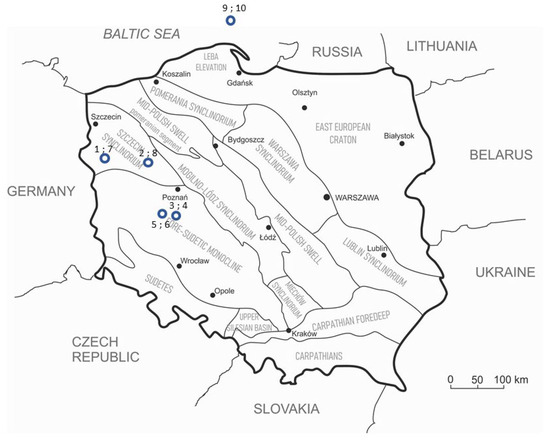
Figure 1.
Location and numbering of the sampled wells (blue circles).
The samples from the Barnówko-1 and Lubiatów-2 wells represent oil-bearing reservoirs associated with the Main Dolomite (Ca2) formation (Figure 2). These rocks originate from a barrier facies zone where sediment grain size and dissolution processes during subaerial exposure resulted in favorable porosity [13,14]. The mineral composition of these samples is very similar (Table 1), with dolomite being the dominant mineral in the rock matrix. These are typically not pure dolomites but mineral assemblages within the calcite–dolomite–ankerite series, with a notable shift toward dolomite. Accessory minerals include quartz grains, celestine, and sphalerite. The cementing material comprises anhydrite and fine dolomite crystals. Anhydrite typically appears as a pore-filling cement, and only rarely as a contact cement. In contrast, dolomitic cement tends to be contact-type, occasionally pore-filling.
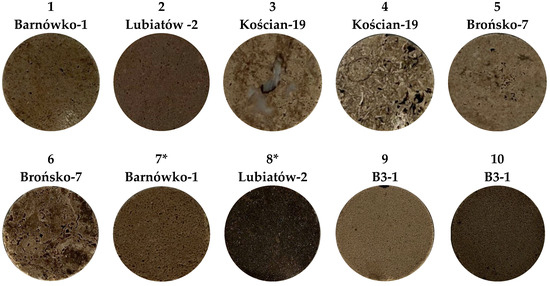
Figure 2.
Photographs of sample sections prepared for SEM examination. Explanation: asterisk (*) denotes oil field sample—oil not extracted.

Table 1.
Stratigraphy, lithology, mineral composition, total porosity, volume, mass, and permeability of the samples.
The samples from Kościan-19 and Brońsko-7 wells—Figure 2—represent natural gas reservoirs associated with the Zechstein Limestone (Ca1). The samples from the Kościan-19 well represent reef carbonate formations; one of the examined sections is strongly impregnated with anhydrite cement and contains large, cement-filled pores. The dominant skeletal mineral is calcite, accompanied by dolomite (Table 1). Mineral transitions from calcite to dolomite are typically continuous, and microscopic examination reveals the presence of ferrocalcite grains (calcite–ankerite series). Cement in these rocks includes ankerite and fine-grained calcite. Calcite cement exhibits both contact and pore-filling characteristics. Anhydrite, where present, displays a pore-filling or locally pervasive character. The distribution of anhydrite in the rock matrix is highly heterogeneous, with large pores occasionally filled by anhydrite, as corroborated by XRD analyses indicating localized anhydrite dominance.
The samples from the B3 field are representative of Cambrian sandstones—Figure 2. Quartz is the primary component of the rock framework, typically exceeding 90% by volume (Table 1). Minor feldspar grains (<1%) are also present. Cementation includes authigenic quartz overgrowths (generally contact-type, occasionally pore-filling), along with patchy accumulations of dolomite, anhydrite, and pyrite—as observed in supplementary SEM analyses.
All the samples were sectioned—Figure 3—for individual testing, including XRD, MICP, SEM, micro-CT, absolute permeability, and rock–fluid–CO2 interaction experiments.
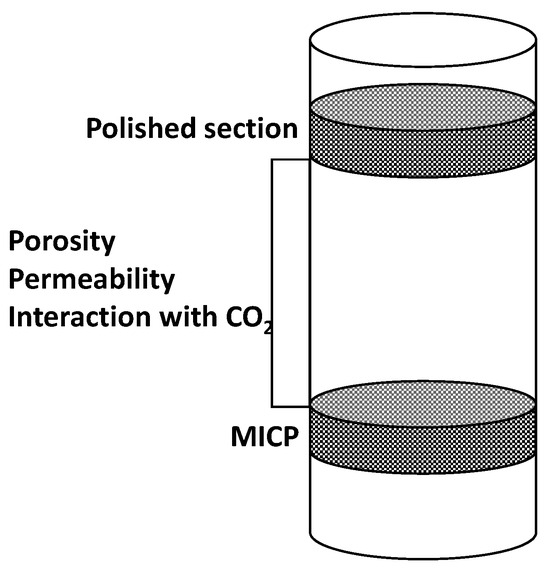
Figure 3.
Division of the core into samples intended for individual tests.
2.2. Research Methods
2.2.1. Mineral Composition
The mineral composition was determined by X-ray diffraction (XRD) using a Bruker (Billerica, MA, USA) D2 Phaser Advance spectrometer. The measurement conditions included a CuKα radiation source, operating at 30 kV and 10 mA, with a 2Θ range of 0–62º and a step size of 0.020º. The detection limit was 0.5% weight percentage. Semi-quantitative phase analysis was performed using the Siroquant V3 software (Mitchell, ACT, Australia), employing the Rietveld refinement method [15].
Mineral phase identification in the samples, both before and after the experiment, was also carried out using a FEI Quanta 650 FEG (Thermo Fisher Scientific, Hillsboro, OR, USA) scanning electron microscope (200 nm resolution) operated at 15 kV, 8–10 nA, and 50 Pa chamber pressure, equipped with an energy-dispersive X-ray (EDAX; Gatan Inc., Warrendale, PA, USA) spectrometer for elemental analysis.
2.2.2. Porosity Determination by Gas Volumetric Method
Total porosity (MPHI) was determined using gas volumetric techniques with helium and nitrogen as the working gases. Measurements were conducted using two instruments: the AccuPyc II 1340 gas pycnometer and the GeoPyc 1360 envelope density analyzer (Micromeritics, Norcross, GA, USA).
Grain density—ρg (g/cm3)—was measured with AccuPyc II 1340, which determines grain volume based on pressure changes in helium gas within a calibrated chamber. The sample mass was input into the instrument software, and the grain volume was calculated automatically. Each sample was measured multiple times to ensure precision, and the results were averaged. The following conditions were maintained: temperature 20 °C ± 0.025 °C, volume accuracy 0.02%, volume repeatability 0.01%, and standard deviation for density 0.003.
Bulk density (ρb g/cm3) was determined using the GeoPyc 1360, which measures the volume of a sample by displacing a dry medium under a known force, simulating confining pressure.
Total porosity was then calculated using the following Equation (1):
2.2.3. Absolute Permeability Determination Using Gas Volumetric Method in Steady Flow
Absolute permeability measurements were carried out using the gas volumetric method under steady-state flow conditions, with both helium and nitrogen as the flowing gases. Permeability was measured in two directions—parallel and perpendicular to the bedding planes—under both atmospheric and simulated reservoir conditions. Klinkenberg correction was applied to account for gas slippage effects.
Permeability (k) is a fundamental property of reservoir rocks that quantifies their ability to transmit fluids. It was determined using Darcy’s Law, expressed as (2):
where k = absolute permeability [mD]; q = volumetric flow rate [cm3/s]; μ = dynamic viscosity of the gas [cP]; L = sample length [cm]; A = cross-sectional area of the sample [cm2]; and ΔP = pressure drop across the sample [Pa].
The key conditions for accurate permeability determination included ensuring laminar flow and complete saturation of the pore space with the measurement gas. Repeated measurements were taken for quality assurance, and data were corrected for gas slippage using the Klinkenberg method where appropriate. The detection limit was 0.001 mD.
2.2.4. Pore Structure Analysis (MICP)
Pore structure analysis and characterization of the pore space were conducted using mercury intrusion porosimetry (AutoPore IV 9500, Micromeritics, Norcross, GA, USA). Measurements were performed on rock samples both before and after autoclave incubation.
The theoretical basis of the MICP (Mercury Intrusion Capillary Pressure) method assumes that the pore space of the rock can be modeled as a microcapillary network consisting of irregularly shaped and arranged pores or capillaries with an idealized cylindrical cross-section. These capillaries are considered pathways for reservoir fluids. The MICP technique exploits the inverse relationship between capillary pressure and pore throat diameter, as described by the Washburn Equation (3) [16]:
where Dc—pore diameter; Pc—pressure; cosθ—contact angle; σ—surface tension; and WASHCON—Washburn constant equal to 0.145038.
By applying the Washburn equation to each measured pressure value, the pore size distribution is obtained, allowing classification of pore sizes based on defined pressure and diameter intervals.
The total pore volume, a key parameter derived from MICP measurements, represents the cumulative volume of mercury intruded into the sample’s pore system under maximum pressure (up to 60,000 psi, corresponding to a minimum resolvable pore diameter of 3.6 nm). The sample volume in porosimetric analysis is primarily determined based on Archimedes’ principle. For monolithic samples, it is considered as the sum of the sample’s skeletal volume and the volumes of both open and closed pores. The skeletal volume is calculated by subtracting the total pore volume from the bulk volume. Using the sample mass, the bulk and skeletal densities are determined, as well as open porosity.
In this study, a re-evaluation of the MICP curves was carried out to obtain the most reliable parameters for pore space characterization and pore typing. The analysis began with a correction of the capillary pressure curves for so-called boundary conditions (commonly referred to in the literature as conformance correction), which account for surface irregularities on the sample [17]. Subsequently, the threshold pressure and the corresponding threshold diameter were determined. Mathematically, this is identified as the inflection point of the cumulative intrusion curve, which, from a physical standpoint, represents the pressure (or pore diameter) beyond which saturation rapidly increases with minimal pressure change. The pore diameter at this threshold defines the critical connectivity within the rock. A higher threshold diameter or lower threshold pressure indicates better filtration (flow) properties of the rock.
The percentage distribution of pores of different diameters within the pore network was determined by quantifying the incremental volumes of mercury intruded at specific pressure intervals. In the interpretation of the results, the following pore size classes were considered: megapores (>10 µm), macropores (10–2 µm), mesopores (2–0.5 µm), micropores (0.5–0.1 µm), and nanopores (<0.1 µm) [18].
Based on the porosity measurements, both grain density and bulk density of the sample were determined. Additionally, the specific surface area was calculated to further characterize the pore structure.
The MICP specifications were as follows: pore diameter range from 1100 (calculated with initial filling pressure of 0.2 psia) to 0.003 µm; resolution 0.03 psia—from atmospheric pressure to 60,000 psia; transducer accuracy +/− 1% of full scale; transducer hysteresis—0.05% of full scale; servo cntrol precision 1% of target (min 0.05 psia); intrusion resolution better than 0.1; intrusion accuracy +/− 1% of max. penetrometer stem volume; standard deviation for porosity 0.05; and porosity detection limit 0.01%.
MICP characterizes pore-throat distributions but samples only small volumes and cannot resolve the full geometry of larger macropores or sparsely distributed conductive channels that may dominate plug-scale permeability. Therefore, the MICP results must be interpreted together with core-flood and imaging data.
2.2.5. μCT Analysis
X-ray computed tomography is based on the acquisition of X-ray projections (digital X-rays) of the examined object for successive angular positions ranging from 0 to 360°. In order to reconstruct the structure of the object under examination, the images are reconstructed. During the reconstruction process, a three-dimensional gray-scale image is created by calculating the absorption coefficients for each point of the object. Higher absorption of the beam is a result of the increased density of the sample, which is related to mineral composition and porosity. Sections of the core with high X-ray absorption correspond to light colors, dark colors correspond to areas of low absorption, and black represents air. Once the reconstruction is completed, it is possible to visualize the data in the form of a 3D image or animation, and arbitrarily oriented 2D cross-sections [19] and images that are extensions of the lateral surface of the core.
X-ray computed tomography measurements were performed using a Benchtop CT160 (Shimadzu, Kyoto, Japan) X-ray microtomograph, with an X-ray source emitting a conical beam of photons with an energy range of 40–160 kV and a theoretical resolution of up to 6 μm (for samples with a diameter of 5 mm and a height of up to 10 mm). Due to the sample size, X-ray computed tomography was performed with a resolution of 15 μm. The software used to process the obtained results was Avizo 3D Pro (Thermo Fisher Scientific, Hillsboro, OR, USA), artificial intelligence (AI)-assisted image segmentation via GeoDict (Math2Market GmbH, Kaiserslautern, Germany). Scans were performed at an effective voxel size of ~15–26 μm (sample-dependent). Pore throats and microporosity below this threshold are not resolved, so μCT-derived porosity and digital-rock permeability provide conservative estimates of flow-effective porosity and miss sub-resolution features detected by MICP/SEM. We therefore use μCT primarily to visualize macropore evolution and channel enlargement rather than as a standalone predictor of permeability.
2.2.6. Experimental Tests
The rock–CO2–brine interaction experiments were conducted under static conditions, excluding additional factors that could influence the reaction rate, such as injection rate, contact time, and water content in the pore space. This experimental design allowed us to reduce costs and improve the reliability of the obtained results. Maintaining a temperature of 50 °C and a pressure of 150–180 bar throughout the experiment ensured that the CO2 remained in a supercritical state. Increasing the pressure and temperature would have produced minor changes in the experimental results. Reservoir pressures in the reservoir rocks from which the samples were taken range from 140 to 180 bar, with temperatures ranging from 80 to 120 °C. The use of a single temperature was partially due to laboratory limitations. We are aware that temperature influences the rate of reactions occurring in brine–rock–supercritical CO2 systems. The influence of pressure related to the penetration of the rock by brine and gas may be even greater; therefore, efforts were made to maintain the reservoir pressure. This approach, however, does not reproduce dynamic injection transients (variable flow rates or shear-driven particle transport) and may bias precipitation/dissolution pathways relative to active injection. Flow-through HTHP tests would complement these data, but were outside the present budget.
After absolute gas permeability tests, the samples were saturated with brine. In the next step, CO2 was passed through the sample. The procedure was repeated 5 times. Then the samples were placed in autoclaves. Prepared rock samples were placed individually into custom-built autoclaves—Figure 4—each made of stainless steel and lined internally with Teflon. The samples were then saturated with synthetic brine formulated to replicate the actual composition of formation waters (Table 2). Air was subsequently removed using a vacuum chamber, and CO2 was introduced through the top inlet. The valves were tightened, and the autoclaves were placed in a water bath maintained at a constant temperature of 50 °C. After 117 days, gas samples were collected from the autoclaves and subjected to molecular and isotopic analysis. The retrieved rock samples were reanalyzed using petrophysical methods (MICP, pycnometry, permeability, SEM) and μCT imaging.
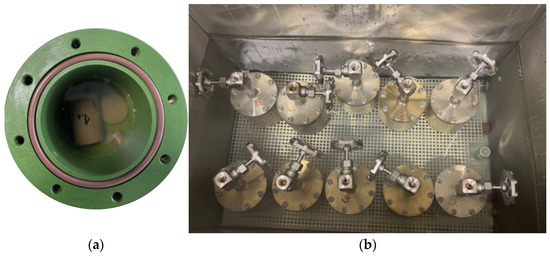
Figure 4.
Interior of the autoclave (a); autoclaves placed in the water bath (b).

Table 2.
Chemical composition of water used in the simulations.
2.2.7. Geochemical Modeling
To assess potential geochemical interactions and their impact on the analyzed collectors, geochemical modeling was performed using the React module of The Geochemist’s Workbench 11 (GWB) software suite [20]. The reactions are simulated in a 10,000 cm3 model, including both minerals and pore space.
The conducted simulations required the compilation of a wide range of input data describing key aspects of the model structure, including the following:
- Mineralogical composition of the rock, determined using XRD diffractometry, and then converted to volume fractions (Table 1);
- Reaction kinetics parameters and specific surface areas of individual minerals;
- Composition of pore water;
- Porosity of the aquifer;
- Fugacity of carbon dioxide (CO2).
The GWB v.11 software package used in this study requires that CO2 pressure values be input in the form of fugacity (fCO2). Simulations were carried out for an assumed initial CO2 pressure of 150–180 bar and a temperature of 50 °C. Fugacity coefficients were calculated based on the model presented by Spycher et al. [21].
The dissolution/crystallization reactions were modeled using the kinetic rate law proposed by Lasaga [22]. According to this formulation (4), a mineral will precipitate from solution if it is supersaturated, or dissolve if it is undersaturated, with the reaction rate dependent on the rate constant and the mineral’s reactive surface area (4):
where rk is reaction rate ([mol·s−1]; dissolution—rk > 0; precipitation—rk < 0); AS—mineral’s surface area [cm2]; kT—rate constant [mol·cm−2·s−1] at temperature T; Qa—activity product [-]; and K—equilibrium reaction for the dissolution reaction [-].
The kinetic parameters used in the simulations (Table 3) were obtained from literature data [23] and adjusted for the formation temperature. The temperature dependence of the rate constant follows the Arrhenius law and was calculated using the equation below (5), accounting for the acidic reaction mechanism:
where k25 is rate constant at 25 °C [mol·m−2·s−1]; E is activation energy [J/mol]; R is gas constant (8.3143 J/K·mol); T is temperature [K]; a is ion activity; indices N, H, and OH refer to neutral, acidic, and basic mechanisms, respectively; and n is the reaction order.

Table 3.
Kinetic rates and specific surface area of minerals used in the simulations.
Approximate values of specific surface area were adopted based on prior work [24]—summarized in Table 3. Simulations employed the thermo.dat thermodynamic database, which utilizes activity coefficients calculated using the extended Debye–Hückel equation. The chemical composition of water used in the reaction kinetics simulations was based on the analytical results of water samples (Table 2) and equilibrated with the mineral phases of each sample. The modeling was conducted in three stages:
- Stage I—Simulation of the effects of CO2 injection into the autoclave; pressure increase with an equilibrium time of 24 h.
- Stage II—Simulation of the effects of injected CO2 on brine and rock over a 90-day period.
- Stage III—Long-term simulation of the effects of CO2–brine–rock interaction over a period of 10,000 years. In this case, however, it should be emphasized that long-term forecasts are conceptual in nature, highlight trends, and do not imply precise quantitative certainty.
3. Results
3.1. Petrophysical Alterations
3.1.1. Porosity and Mass Changes
All ten plug samples exhibited an increase in total porosity (helium-measured) (Δtotal porosity = 0.53–4.33%) and a concurrent decrease in dry mass (Δmass = −0.04 g to −1.16 g) after CO2–brine interaction (Table 4). The largest porosity gains (4.08–4.33%) occurred in the Barnówko 1 plugs (samples Ba1-1 and Ba1-7), which are dominantly dolomitic; these same plugs also showed the greatest mass loss, indicative of substantial mineral dissolution. Smaller but consistent porosity increases (1.03–3.85%) were recorded in the Lubiatów 2, Kościan 19, Bronsko 7, PB 2A, and PB 3A samples. A relatively big mass loss in Sample 7—Barnówko 1 (Δmass = −1.16 g)—likely reflects a release of higher-hydrocarbon fractions, as confirmed by gas analyses from the autoclave.

Table 4.
Porosities, permeabilities, and sample masses before and after the experiment.
3.1.2. Absolute Permeability—K
Absolute permeability generally rose in seven of the ten samples (Δk = +3.87 to +366 mD), with the most dramatic increases in the calcite-rich Kościan 19 plugs (Sample 3: +366 mD and Sample 4: +334 mD), consistent with extensive calcite and dolomite dissolution opening new pore throats. Smaller permeability enhancements (5–27%) were observed in the remaining samples except Samples 1, 6, and 10, which experienced permeability declines (Figure 5, Table 4). In these latter plugs, it is likely that precipitation of CO2-derived secondary phases (anhydrite) or carbonate re-crystallization (described in more detail in Section 3.3. Microstructural SEM Observations) occluded key flow channels.
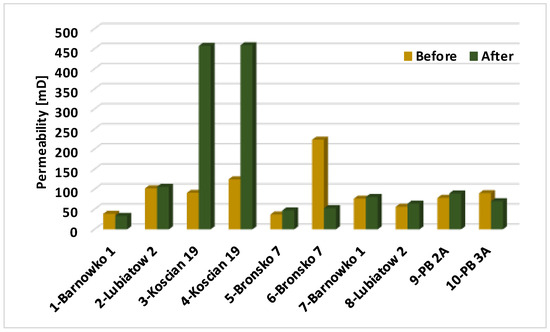
Figure 5.
Permeability change after CO2–rock–brine interaction.
3.1.3. Mercury Injection Capillary Pressure (MICP) and Sub-Microporosity
MICP analyses on end-faces of each plug reveal how pore-size distributions above 0.003 µm shift during reaction. Comparing MICP porosity to helium porosity allows estimation of “sub-microporosity” (<0.003 µm). In nine of the ten samples, sub-microporosity increased markedly after reaction (Δ = +1.05 to +9.86%), indicating creation of new micropores (Figure 6, Table 4). This secondary microporosity likely arises from selective mineral dissolution at grain boundaries and intraparticle contacts, as confirmed by SEM imaging. However, these newly created sub-micropores do not significantly contribute to flow, explaining why some samples with increased MICP porosity show only modest permeability gains.
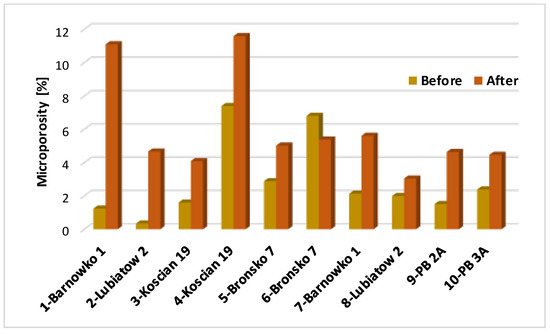
Figure 6.
Microporosity change before/after CO2–brine exposure.
Detailed pore-size distribution curves, presented in Figure 7, highlight sample-specific trends:
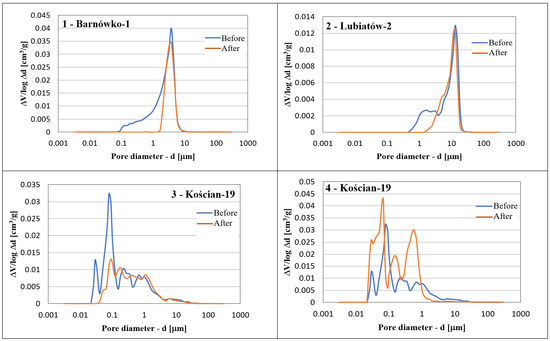
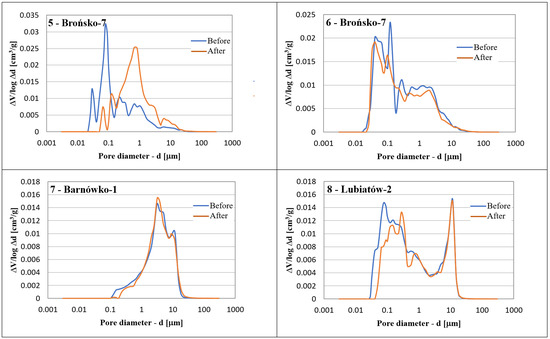

Figure 7.
Pore size distribution in samples before (blue curve) and after (orange curve) interaction with brine and CO2. Note: all pore-size distributions report equivalent throat diameters derived from capillary pressure; resolution limits (~0.005 µm to ~100 µm) exclude the majority of sub-resolution micropores that may nonetheless influence transport of fluids.
- Sample 1: The pore-size distribution before and after CO2–brine exposure shows a reduction in pore volume in the 0.1–10 µm diameter range. This loss of intermediate-sized pores led to a decrease in porosity as measured by MICP and was accompanied by a reduction in permeability. The observed changes are attributed to the clogging of pore throats by precipitated phases.
- Sample 2: After reaction, pores of 0.5–3.8 µm diameter decreased in volume, while those in the 3.8–11.3 µm range increased. Although total porosity declined slightly, the enlargement of larger pores enhanced permeability.
- Samples 3 and 4: MICP data alone cannot fully explain the large permeability increase in these plugs. In Sample 3, pores < 0.12 µm were replaced by larger pores. In Sample 4, pore volume grew in the 0.2–0.8 µm range and in the 0.1–0.8 µm range specifically through calcite dissolution. Both samples had relatively low MICP porosity that decreased further after reaction. However, µCT analysis reveals the development of large macropore channels outside the MICP detection window, accounting for the dramatic permeability gains.
- Sample 5: Pore volumes < 0.12 µm diminished, while pores > 0.12 µm grew. This shift resulted in a slight porosity decrease but a measurable increase in permeability.
- Sample 6: A general reduction in pore volume occurred across the entire measured range. Despite this slight porosity loss, permeability dropped substantially. This anomalous behavior is best explained by blocking of the principal flow channels via pore-throat crystallization during CO2 interaction, highlighting the difficulty of extrapolating thin-section MICP data to plug-scale flow properties in carbonates.
- Sample 7: Minor pore-volume decreases were observed in the 0.1–0.8 µm range, with small increases in the 1.3–3.8 µm and >15 µm classes. These modest shifts produced negligible changes in both porosity and permeability.
- Sample 8: Ores < 0.23 µm lost volume, while those in the 0.23–0.35 and 0.35–0.6 µm ranges gained volume. The net effect was a slight increase in porosity and permeability.
- Sample 9: Volume decreased for pores < 0.03 µm and in the 0.05–0.07 and 0.12–0.22 µm ranges, but increased in the 0.03–0.05 and 0.07–0.12 µm classes. Porosity remained essentially unchanged, yet permeability rose—likely due to heterogeneous cement distribution within the sample.
- Sample 10: Following CO2 exposure, pores in the 0.01–0.02, 0.04–0.08, 0.12–0.18, and 0.27–0.43 µm ranges expanded, while all the other size classes contracted. These changes yielded a slight porosity decrease but a pronounced permeability decline, probably caused by halite precipitation blocking the flow pathways.
3.2. MicroCT Observations of Rock Alterations Induced by CO2 Injection
Sample No. 4—Kościan-19—was selected based on the presence of macroscale pores and channels suitable for volumetric visualization at the available microCT resolution (26 μm voxel size). The primary objective was to assess changes in pore space morphology, porosity distribution, and flow pathways induced by geochemical interactions. The sample exhibited connected macropores and heterogeneous pore geometry, making it a representative candidate for assessing CO2-induced alterations. Scans were performed both before and after the experiment using two segmentation strategies:
- Conventional grayscale thresholding and boundary-based segmentation using Avizo 3D Pro (Thermo Fisher Scientific, Hillsboro, OR, USA), applied to the entire core volume.
- Artificial intelligence (AI)-assisted image segmentation via GeoDict (Math2Market GmbH, Kaiserslautern, Germany), applied to a subvolume extracted from the interior of the sample.
The latter approach excluded near-edge pore structures that do not contribute to permeability during laboratory flow tests and thus provided a focused estimate of changes in effective porosity and transport pathways.
Binary segmentation via Avizo showed minimal change in porosity, with an estimated increase of +0.09%, indicating limited net growth of the total void volume. In contrast, the AI-assisted GeoDict analysis revealed a net decrease in porosity of −3.6%, suggesting partial pore occlusion due to mineral precipitation. This discrepancy highlights the sensitivity of segmentation methodology and the spatial heterogeneity of pore evolution. Despite the apparent porosity reduction, permeability was observed to increase, as evidenced by an expansion of large flow-effective pore channels. Visualization of the 3D CT data confirms that selected macropores in the sample interior experienced significant enlargement due to mineral dissolution, particularly in zones initially occupied by soluble phases such as calcite or dolomite. These pores now exhibit enhanced connectivity and flow capacity—Figure 8.
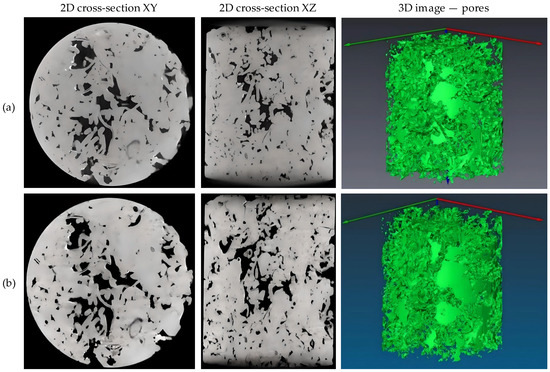
Figure 8.
Sample 4, CT images: (a)—before and (b)—after the experiment. The arrows indicate the directions: X axis—red, Y axis—green. Note: The resolution limit (~26 μm voxel) excludes sub-resolution pore classes; small-scale features are thus characterized by MICP/SEM rather than by CT.
Figure 9 illustrates the classification of the connected (blue) versus isolated (yellow) pores. The proportion of the isolated pores increased slightly (by approximately 0.3%) following CO2 exposure. This may result from the partial sealing of originally interconnected pores by secondary mineral precipitates, potentially iron oxides, as inferred from their high-density signal on CT slices.
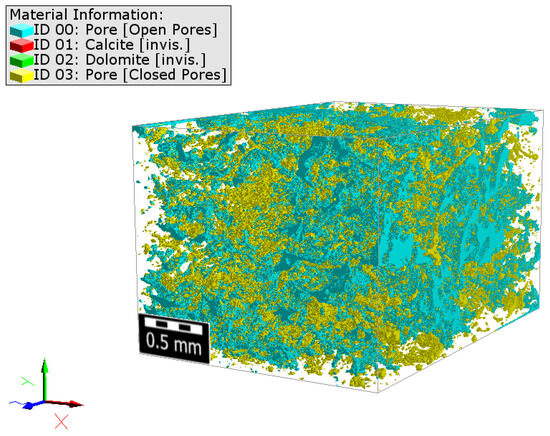
Figure 9.
Sample 4—visualization of connected pores and closed pores. Note: The resolution limit (~26 μm voxel) excludes sub-resolution pore classes; small-scale features are thus characterized by MICP/SEM rather than by CT.
Flow simulation using the Navier–Stokes equations, based on the segmented pore volume, enabled estimation of localized fluid velocities (Figure 10). Fastest flows were recorded within the main interconnected channels, particularly where pore throats had widened. However, flow remained constrained in marginal zones due to the presence of narrow, poorly connected pores. Most calculated percolation paths passed through pore throats of ≤45 μm diameter (Figure 11), a size class below the detection threshold of mercury intrusion porosimetry and thus not visible in conventional petrophysical analyses.
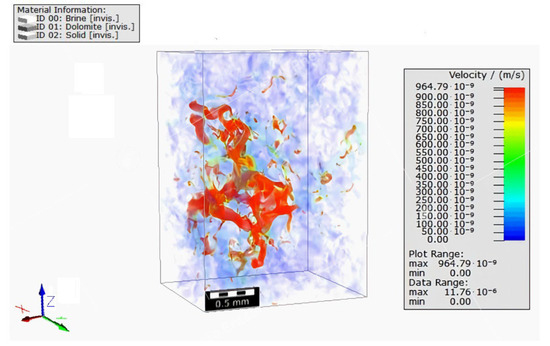
Figure 10.
Sample 4—flow velocity map. Note: The resolution limit (~26 μm voxel) excludes sub-resolution pore classes; small-scale features are thus characterized by MICP/SEM rather than by CT.
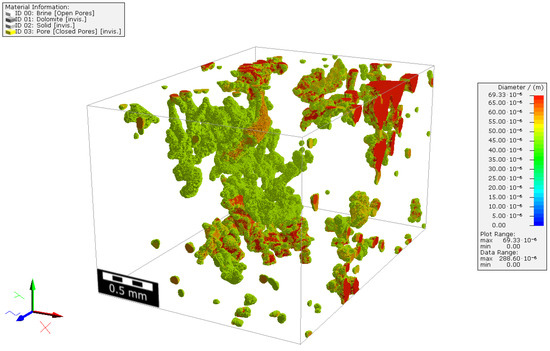
Figure 11.
Sample 4—open porosity—pores up to 45 μm. Note: The resolution limit (~26 μm voxel) excludes sub-resolution pore classes; small-scale features are thus characterized by MICP/SEM rather than by CT.
Quantitative pore volume classification pre- and post-experiment—Table 5—reveals several notable trends:

Table 5.
Sample 4—quantitative pre- and post-experiment pore volume classification.
- The dominant pore class remains >1,000,000 voxels (>1040 mm3), representing ~89–90% of total pore volume.
- Mid-sized pore classes (104–105 and 105–106 voxels) show minor reductions in volume, consistent with partial infill or consolidation.
- The total number of pores increased from 5743 to 8423, indicating the formation of new small-scale features or segmentation artifacts.
The cumulative pore volume increased from 1169.5 mm3 to 1213.0 mm3, corresponding to a net porosity rise from 9.83% to 9.92%. These results apply to pores larger than 26 μm, the resolution limit of the CT system.
The spatial resolution of our μCT analysis limits its ability to capture the evolution of smaller micropores. For this reason, μCT was employed specifically to characterize changes in the distribution of pores larger than 15 µm, where it provides reliable quantitative information on connectivity and channelization. Carbonate rocks, however, are characterized by pore systems spanning several orders of magnitude in size, from nanometers to millimeters, making it impossible to resolve the entire pore spectrum with a single technique. To overcome this limitation, we complemented μCT with mercury intrusion capillary porosimetry (MICP), which is sensitive to submicron-scale pore throats. This multi-method approach ensures that both the fine-scale microporosity and the larger connected macropores are captured, thus providing a more complete and robust interpretation of porosity and permeability changes. Importantly, neglecting micropores could underestimate processes such as self-sealing by secondary precipitates or fine-scale solubility trapping; by combining μCT with MICP, our workflow accounts for these mechanisms more comprehensively, which is critical for evaluating the long-term sustainability and safety of CO2 storage.
3.3. Microstructural SEM Observations
The SEM images of the carbonate cores (1—Barnówko-1; 2—Lubiatów-2; 3 and 4—Kościan-19; and 5 and 6—Brońsko-7) before CO2 exposure show intact frameworks of intergrown dolomite, calcite, and minor anhydrite with smooth grain surfaces and isolated small pores. After CO2 injection, widespread etching and new porosity are apparent on grain surfaces. For example, Barnówko-1 (Samples 1 and 7) initially had large anhydrite grains filling pore spaces and smooth dolomite fragments with few micropores—Figure 12a. Post-injection, these anhydrite grains exhibit dissolution features and enlarged pore cavities, while dolomite grain surfaces develop numerous small pits (secondary pores). Pore spaces are now cleaned of hydrocarbons (previously visible in SEM images), and fresh rhombohedral dolomite crystals have nucleated on dolomite grain boundaries. These features—dissolution pits on carbonate crystals and secondary dolomite precipitation—indicate acid-driven reactions of CO2-saturated brine with the rock. The literature predicts that carbonic acid will lower pH and preferentially dissolve carbonate minerals [25], with calcite dissolving most rapidly and dolomite more slowly [26]. Consistent with this, Barnówko-1 shows moderate dolomite corrosion (no calcite was noted in this sample) and only incipient anhydrite dissolution—Figure 12b.
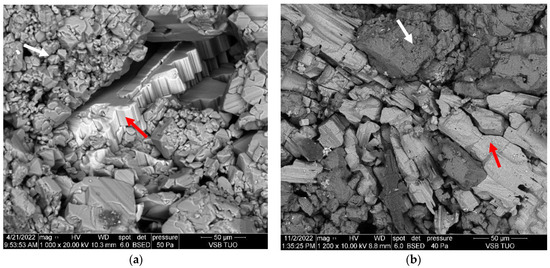
Figure 12.
Barnówko-1—depth 3056.58 m; (Sample 7): (a)—before the experiment—dolomite forms the rock framework (white arrows); anhydrite grains occupy pore space (red arrows). Surfaces are clean; large pores are empty. Dolomite exhibits variable Ca–Mg composition. (b)—after the experiment—strong dissolution of anhydrite (red arrows) and dolomite grains at contact zones (white arrows). Pseudo-microcracks result from intergranular dissolution.
Lubiatów-2 (Samples 2 and 8) displays a similar pattern. Before CO2, the rock is a dolomite-crystal framework with anhydrite fillers—Figure 13a; after exposure, many secondary dolomite crystals coat grain surfaces, and new microporosity appears in the dolomite. In one Lubiatów-2 sample, subhedral anhydrite “mini-crystals” are even observed on dolomite surfaces after reaction, suggesting some dissolved sulfate re-precipitated—Figure 13b. Overall, CO2-acid attack produced many fine pits and intervening voids on dolomite grains and generated new pore-filling minerals. This is in line with expected reactivity (calcite > dolomite) and with reports that CO2-induced carbonate dissolution increases porosity. In fact, dissolution of calcite–dolomite tends to enlarge pore volume while any precipitation (e.g., of anhydrite or salts) can reduce it.
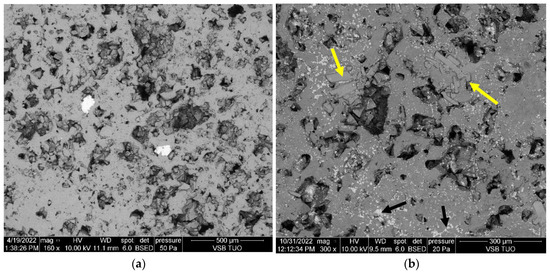
Figure 13.
Lubiatów-2—depth 3275.2 m; (Sample 2): (a)—before the experiment—dolomite grains form the rock matrix; large pores are clean and partially filled by dolomite crystals. Dolomite surfaces remain smooth with few fine pores. (b)—after the experiment—secondary anhydrite crystals (yellow arrows) occur on dolomite grain surfaces, and small crystals of halite (black arrows).
In the calcitic–dolomitic samples from Kościan-19 (Samples 3 and 4), pre-injection SEM shows intergrown calcite and dolomite crystals with minor anhydrite in pores—Figure 14a. After CO2 exposure, calcite grains are intensely etched: SEM shows deep “vugs” and etch pits on calcite surfaces, and the grains are broken into fragments with open boundaries. Dolomite crystals also dissolve, but more subtly—only small micropores appear on their surfaces. Notably, fine scalenohedral calcite spar has precipitated between the dissolved grains in both samples, indicating secondary carbonate growth—Figure 14b. These observations (strong calcite corrosion, weaker dolomite loss, and secondary calcite cements) match the expectation that calcite is much more reactive with CO2-acidified fluids than dolomite [27]. The newly formed microporosity and micro-cracks between grains indicate that primary porosity has increased.
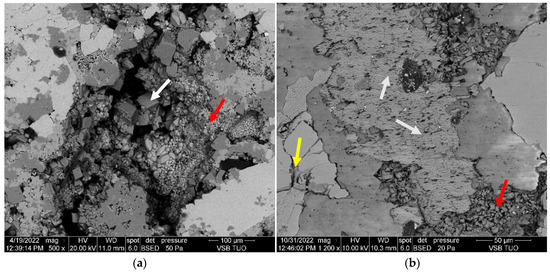
Figure 14.
Kościan-19—depth 2201.58 m; (Sample 3): (a)—before the experiment—dolomite (white arrows) and calcite (red arrows) crystals occupy pore space; some pores contain organic matter. Grain surfaces are smooth with few small pores. (b)—after the experiment—dissolution pits in calcite grains indicate intense surface dissolution (white arrows). Secondary calcite crystals (red arrows) are observed below. On the left, a dissolved anhydrite (yellow arrows) grain is present. Small secondary pores appear in dolomite grains above.
Brońsko-7 (Samples 5 and 6) shows the same trends. Before reaction, both intervals contain calcite–dolomite matrices with pore-filling anhydrite. After CO2, anhydrite grains are partly dissolved, and the adjacent dolomite or calcite surfaces are etched. In the 2135 m sample, anhydrite dissolution is prominent, and many secondary dolomite crystals appear in pores. In the 2118 m sample, the calcite grains are most severely corroded—large etch pits and micro-fissures form on calcite, while neighboring dolomite is less affected. These textures (selective dissolution at grain contacts, creation of pseudoporous microcracks) reflect typical CO2-fluid interactions that favor calcite dissolution. In both Brońsko-7 samples, the net effect is generation of new pore space (secondary porosity) amid some precipitation of secondary carbonates (mostly dolomite).
Across all the carbonate cores, SEM reveals that CO2-rich brine caused partial dissolution of primary carbonate minerals (calcite and dolomite) and even some anhydrite, producing abundant new micropores and etch textures. This dissolution is accompanied by minor precipitation of secondary phases (dolomite or calcite cements on grain surfaces, plus small anhydrite or NaCl crystals in some pores). The dominance of dissolution (especially of calcite) over precipitation is consistent with known reaction kinetics under CO2 acidity. As a result, a change in porosity occurs, which is the result of an equilibrium: dissolution of carbonates increases pore volume and pore connectivity, while secondary mineral growth can cause pore throats to close.
The quartz-rich sandstones exhibit a markedly different SEM response. Initially, both PB-2A and PB-3A consist of tightly packed quartz grains with concavo-convex contacts and quartz cement rims; minor “patchy” Fe–Mn–dolomite cement is locally present—Figure 15a and Figure 16a. Large pore spaces are clean in the unreacted samples. After CO2 injection, the most striking feature is extensive salt precipitation: SEM clearly shows cubic and hopper-shaped NaCl crystals coating many quartz grain surfaces and lining pore walls in both samples. These NaCl druses and coatings were absent before the reaction. Some quartz dissolution is also evident at grain contacts—quartz rims appear partially etched and grain boundaries become more pronounced after reaction—Figure 15b and Figure 16b. The few carbonate cement grains have mostly dissolved (as seen by the disappearance of isolated dolomite patches), but importantly, no new carbonate minerals are observed; instead, salt dominates the post-reaction texture.
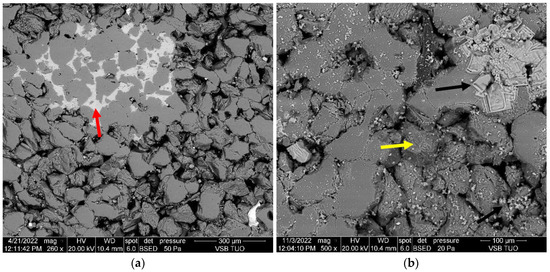
Figure 15.
PB-2A—depth 1421.6 m; (Sample 9): (a)—before the experiment—quartz framework with quartz overgrowth cement; local patches of Fe–Mn dolomite carbonate cement (red arrows). (b)—after the experiment—quartz grains show initial dissolution (yellow arrows). Grain boundaries become sharper, likely due to quartz dissolution. Fine NaCl crystals and coatings form on grain surfaces (black arrows).
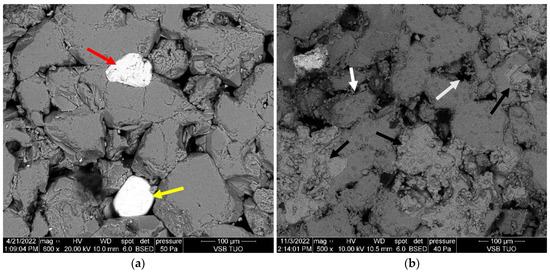
Figure 16.
PB-3A—depth 1423.4 m; (Sample 10): (a)—before the experiment—quartz framework with quartz overgrowth cement; concave–convex grain contacts. Surfaces are smooth; large pores are clean. Dolomite grain visible at top (red arrows), anatase (TiO2) grain below (yellow arrows). (b)—after the experiment—fine NaCl crystals and coatings appear on quartz grains (black arrows). Pore space also contains small quartz crystals (white arrows).
This behavior reflects the “drying front” effect known for CO2 flooding of brine-filled sandstones [28]. Injecting supercritical (dry) CO2 displaces pore water and causes evaporation of the brine, leading to NaCl crystallization. Our SEM images confirm that behavior: as the pore fluid evaporated, salt precipitated in pores and on grain surfaces, potentially clogging pore throats. In effect, porosity in the sandstone is reduced by salt fills. In contrast to the carbonates, there is no evidence of enhanced pore space from mineral dissolution—quartz dissolved only slightly, and the few carbonate cements were negligible. The formation of halite cements after CO2 exposure can substantially decrease permeability, a concern for injectivity [29]. No significant secondary calcite or dolomite was formed in these quartz sandstones, so CO2 mineral-trapping via carbonate precipitation appears negligible in these samples.
3.4. Geochemical Modeling Outcomes
The reactive-transport modeling was carried out in three successive stages:
- Stage I—Simulation of CO2 injection into the autoclave up to the prescribed pressure over 24 h.
- Stage II—Simulation of the interaction between the injected CO2, brine, and the rock, over 90 days.
- Stage III—Long-term simulation of CO2–brine–rock reactions extending over 10 000 years.
3.4.1. Autoclave CO2 Injection
Following equilibration at 50 °C and an fCO2 of 80 bar for 24 h, all the carbonate-bearing samples exhibited a substantial pH decrease, from initial values of 6.0–6.7 down to 4.1–4.7 (sandstones: from 5.8 to 4.2) (Table 6, Figure 17). The dissolution of CO2 into the aqueous phase led to carbonic acid formation (6):
whose dissociation released H+ and drove this pH decline (7):
CO2 (aq) + H2O → H2CO3 (aq),
H2CO3 → 2H+ + CO32−.

Table 6.
Porosity and pH changes after 1 day, 90 days, and 10,000 years of CO2 exposure. Yellow cells denote increases; blue cells denote decreases.

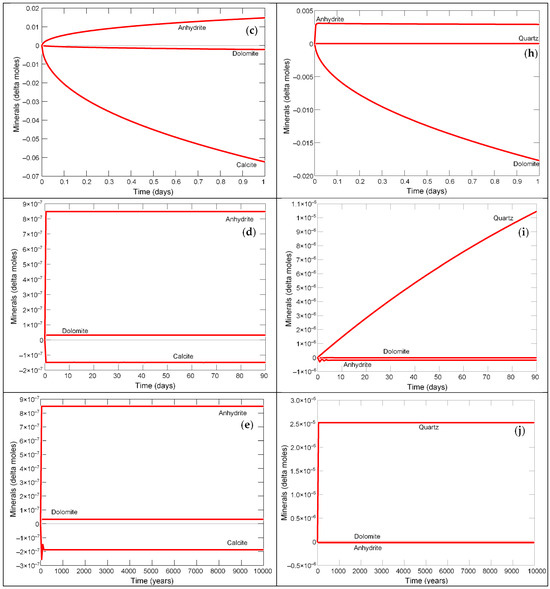
Figure 17.
Samples 3, limestone (a–e) and 10, sandstone (f–j): variations in pH (a,f), porosity (b,g), and mineral volumes during 1 day CO2 injection (c,h), and subsequent 90 days (d,i) and 10 000 years of storage (e,j).
Porosity increased marginally across all the samples—by 0.05 to 0.26 percentage points—due to calcite and/or dolomite dissolution in a volume larger than that of anhydrite precipitating under these conditions (8) and (9) (Table 6 and Table 7, Figure 17).
Calcite + SO42− + CO2(g) + H2O = Anhydrite + 2HCO3−
Dolomite + SO42− + 2CO2(g) + 2H2O = Anhydrite + Mg2+ + 4 HCO3−

Table 7.
Mineral volume changes after 1 day, 90 days, and 10,000 years of CO2 exposure. Yellow (+) indicates precipitation; blue (−) dissolution; green (0) no change; gray mineral absence.
3.4.2. Interaction over 90 Days
Maintaining fCO2 at 80 bar over 90 days produced negligible growth in pH (ΔpH ~10−9–10−7) except for Sample 6, which showed a very slight pH decrease of 10−6 (Table 6). Porosity changes were similarly minimal (Δϕ\~10−8–10−5), with Sample 5 as the only exception, exhibiting a minor porosity increase of 10−9 (Table 6). In carbonate rocks, these small porosity losses reflect marginal net anhydrite and/or dolomite (10) precipitation overtaking quartz, calcite, or dolomite dissolution; in quartz-rich sandstones, quartz recrystallization dominated (Table 7, Figure 17).
Calcite + CO2(g) + Mg2+ + H2O = Dolomite + 2H+
3.4.3. Long-Term Simulation over 10,000 Years
Over the 10,000-year timescale at constant fCO2 = 80 bar, the trends observed at 90 days persisted: pH exhibited only infinitesimal increases (10−8–10−7) except in Sample 6, where pH decreased by 10−6, and porosity changes remained within ±10−7–10−9 (Table 6). Mineralogical evolution continued to mirror that of the intermediate term, with slight net precipitation or dissolution depending on sample composition (Table 7), indicating that the geochemical system approached a quasi-steady state under prolonged CO2 exposure (Figure 17).
4. Discussion
Laboratory core-flood permeability tests capture the net effect of dissolution and precipitation on fluid flow, whereas MICP samples only a limited volume and miss large, connected macropores. Combining core-scale and pore-scale analyses yields a more comprehensive understanding of CO2-induced alterations. The coupled core-flood, microstructural, and porosimetry data reveal that CO2–brine–carbonate interaction drives both enhancement and impairment of flow properties, in general, consistent with previous studies on CO2 storage-induced petrophysical changes. Our studies revealed that the following phenomena and mechanisms control the behavior of samples under CO2 exposure:
- Selective dissolution in calcite-rich samples—The pronounced permeability gains in Samples 3 and 4 (Kościan 19) align with the observation that CO2-acidified brine dissolves calcite preferentially over dolomite (confirmed by our reaction model—Figure 17), which may trigger a rapid widening of critical pore throats and even “wormhole” development in carbonate cores [30]. Their experiments showed up to a 200% increase in permeability for high-calcite content rocks, similar in magnitude to our 268–402% enhancements. In our case, confirming of true wormholing phenomenon would require higher µCT spatial resolution and temporal coverage (e.g., sub-10 µm µCT or FIB-SEM on targeted subvolumes, time-lapse imaging during core-floods, or tracer/particle tests). Thus, we describe the pattern as incipient non-uniform dissolution with localized channel widening rather than definitive field-scale wormholing.
- Moderate or negative response in dolomite-dominated intervals—Dolomite-rich samples (e.g., Barnówko 1, Lubiatów 2, and Brońsko 7) exhibited modest permeability increases (5–27%) or even declines (Brońsko 7, Sample 6). This may be due to slower dolomite dissolution, often accompanied by secondary precipitation (e.g., magnesian calcite) that can seal pores and mitigate permeability gains. Espinoza and Santamarina [31] also noted that precipitation of Mg-rich phases during CO2 injection can reduce pore throat sizes and offset dissolution-driven porosity increases.
- Microporosity growth versus connectivity—Most samples developed additional microporosity (MICP data), but connectivity remained poor unless dissolution accessed larger throats. Isolated micropores have little effect on flow—in our SEM observations, we identified only small etch pits with limited macroscopic effect. MICP indicates microporosity growth, but high capillary pressures in micropores generally preclude their contribution to advective flow; therefore, microporosity increases are not directly equated to permeability gains without evidence of throat-scale connectivity.
- Role of secondary mineral precipitation—The permeability decline in Sample 6, despite carbonate dissolution elsewhere, highlights the importance of pore-throat clogging by secondary phases. Fe, Ca, and SO4 released during CO2–brine–rock interaction can re-precipitate as iron oxy-hydroxides and anhydrite within pore throats, causing permeability reductions up to 50% in sandstone and carbonate cores. Our SEM images likely support the existence of secondary Fe-oxides; their precipitation in constricted channels isolates pore pockets and diminishes flow capacity. We note that SEM/EDS and CT suggest precipitates that can occlude throats, but quantifying their impact on long-term field injectivity requires flow-through experiments and particle-transport monitoring beyond our static tests.
The contrasting petrophysical responses highlight the importance of reservoir mineralogy and heterogeneity in predicting injectivity. Gaus [3] emphasized that carbonate reservoirs may self-enhance injectivity, but also warned of potential self-sealing where precipitation predominates. Our results confirm this dual behavior: calcite-rich zones may act as high-permeability conduits, while dolomite-rich intervals may form low-permeability barriers over time.
In our µCT study the bulk porosity changed by 0.9%, indicating very limited net mineral loss. However, this small bulk effect masks strong local effects. The images reveal local dissolution and slight widening of the main flow conduit, with most of the pore space essentially unaltered. This pattern of several enlarged channels amidst nearly intact pores may indicate the beginning of early non-uniform dissolution. Al-Khulaifi et al. (2019) [32] found that CO2-saturated brine created a dominant flow channel in carbonate cores, with acid attack focused along pre-existing high-velocity paths. In agreement, our sample’s central channel enlarged slightly while the surrounding matrix saw little change. Pore-structure heterogeneity often leads to such channeling rather than uniform porosity gain. In other words, only a tiny fraction of the carbonate dissolved (hence ≪ 1% porosity gain), because the reaction became localized once fast pathways formed.
The slightly divergent porosity results from two segmentation methods (Avizo vs. AI) underscore how quantification can depend on image processing. Regardless, both indicate almost no net porosity gain. This implies that any void space created by CaCO3 dissolution was partly counteracted by other processes. In fact, our images show an increase in isolated (dead-end) pores and a population of very dense precipitates (likely iron oxy-hydroxides). The inferred Fe-oxide grains suggest that ferrous iron in the rock (from, e.g., pyrite, ankerite, or clays) may have been mobilized and re-precipitated as CO2 outgassed or pH changed locally. Similar secondary Fe precipitates have been observed to occupy pore throats in aquifers, reducing pore volume and permeability (Cao et al., 2024) [33]. In our case, these occlusions likely coated grain surfaces or clogged small channels, isolating pore pockets. Such pore-blocking explains why the isolated-porosity fraction rose even though total porosity hardly increased.
This interplay of dissolution and clogging has a direct impact on permeability. The pore-scale flow simulation showed that connected flow was carried by pores ≤ 45 µm in diameter—essentially the fine end of the throat distribution. In porous carbonates, the largest connected pores or throats typically dominate permeability. Dissolution enlarges those critical paths first, so permeability can change dramatically if a “breakthrough” path forms. Conversely, if precipitates or fines plug these pathways, permeability can drop even as total porosity rises or stays constant. For example, Ellis et al. [34] found that a carbonate fracture lost permeability despite net mineral removal because dissolved fines migrated and clogged the flow path. In our sample, the new precipitates likely increased tortuosity, so that gains from channel widening were offset by reduced connectivity. Our emphasis on the balance between dissolution-driven channelization and precipitation-driven clogging is also supported by Gao et al. [35], who investigated dissolution and precipitation effects in tight sandstone reservoirs exposed to CO2-saturated brine. Using core flooding and imaging, they showed that while dissolution enhances porosity and permeability locally, secondary mineral precipitation may partially offset gains. The experimental results by He et al. [36] also revealed significant mineralogical changes, particularly dissolution of carbonates and clays, leading to pore structure reorganization. They emphasize that heterogeneity strongly controls reaction pathways in reservoir formations, see also Wang et al. [8], who found that pore-scale heterogeneity is a critical determinant of storage efficiency.
Computed permeability from the µCT images may therefore diverge from laboratory values. Imaging misses sub-resolution porosity and cannot capture mechanical effects (grain detachment, pore collapse) that occur in core floods [6]. Smith et al. [37] noted that even a small fraction of calcite dissolution dominated permeability in mixed carbonate plugs, and they emphasized that high-resolution imaging is needed to reliably link porosity and permeability. In practice, digital-rock simulations often overpredict permeability if fine pores are unresolved or if clogging is neglected. Thus, the mismatch between the laboratory and simulation results is due to both image resolution limits and the complex pore-scale physics (e.g., particle transport, wettability) not captured in simple Navier–Stokes models.
The observed processes suggest a delicate balance in injectivity and long-term storage. Initial larger pore expansion could enhance injectivity along preferential paths, but widespread precipitate clogging would impair it. The increase in the isolated pores signals potential formation of self-sealing zones, similar to those reported in caprocks. Gherardi et al. [38] showed by modeling that carbonate precipitation at caprock/reservoir interfaces can “heal” leakage pathways if fluid transport is diffusion-limited. Likewise, carbonate precipitation in contacted pore spaces (from mixed pH or ion fronts) can increase trapping. Our suspected Fe-oxide and any carbonate re-precipitates might likewise reduce permeability in CO2 migration paths, enhancing caprock integrity in places.
Conversely, the partial dissolution also releases ions that carry CO2 as dissolved bicarbonate, representing a geochemical trap. However, dissolution in a carbonate caprock can also mechanically degrade seals by removing asperities, as observed by Ellis et al. [34]. In our case, the net effect on permeability appears small, but the trend toward occlusion suggests injectivity could fall off over time if flow channels clog. For storage efficiency, the dominant fine pore connectivity means that the capacity of the reservoir to dissolve and mineralize CO2 may be limited by the rate at which precipitates or fine particles isolate the pore network. In summary, the pore-scale alterations we observe—modest porosity change with focused channeling and local clogging—are consistent with the literature on CO2–brine–carbonate interactions. These results underscore that even slight dissolution can significantly alter flow patterns, and that concurrent precipitation (iron-oxide or new carbonates) can greatly influence injectivity and caprock sealing behavior.
The SEM observations indicate that CO2 injection induced selective rock–fluid reactions. Carbonate minerals (calcite and dolomite) dissolved to create new micro- and secondary porosity, while quartz remained largely inert. In carbonates, calcite etching dominated and generated abundant fine porosity (consistent with the literature (e.g., Mazzullo, [39]). The new pores and micro-cracks seen at the calcite–dolomite grain boundaries imply that bulk porosity and connectivity were enhanced, which could increase storage capacity. However, some of this porosity is partially back-filled by secondary precipitates (dolomite or calcite cements and minor anhydrite), as also noted in related studies (e.g., ref. [40]). In sandstones, by contrast, porosity evolution is dominated by salt deposition rather than carbonate dissolution; the resulting salt crusts can obstruct flow paths. Our findings are consistent with recent laboratory studies by Nooraiepour et al. [41] showing that in sandstones, porosity evolution is largely controlled by salt precipitation rather than carbonate dissolution. CO2-induced brine dry-out and subsequent salt crystallization were shown to obstruct flow paths and reduce mechanical integrity, with the affected sandstones experiencing up to 50% reductions in elastic moduli and heightened risk of stress localization. These results emphasize that in saline aquifers, salt crust formation represents a key mechanism of injectivity loss and potential geomechanical weakening, aligning with the pore-scale clogging observed in our experiments.
These microstructural changes have important implications for reservoir integrity and storage potential. Enhanced carbonate dissolution in the reservoir can increase pore space and improve CO2 injectivity and capacity, but it may also weaken the rock framework if grain contacts are eroded, potentially leading to compaction or fracturing under stress [42]. Conversely, precipitation of anhydrite or NaCl can reduce effective porosity and permeability, posing a risk of flow impedance near the injection site [43]. Our SEM results suggest that calcite-rich zones will preferentially generate secondary porosity and may act as fast pathways, whereas zones rich in anhydrite or susceptible to salt precipitation could become bottlenecks. In summary, CO2–fluid–rock reactions in these samples created a heterogeneous pore network: carbonate dissolution enhanced local porosity (favorable for storage), but concomitant mineral precipitation could locally obstruct pores. Understanding this balance is critical for predicting CO2 plume migration and long-term reservoir behavior in similar geologic storage settings.
Geochemical modeling was performed in three stages and revealed specific behaviors of gas–rock–brine systems:
- Early (hours) phase—rapid acidification and carbonate dissolution: Injection of CO2 into the brine instantly forms carbonic acid, sharply lowering the pH (by 1–2 units within minutes). The acidic fluid dissolves carbonate minerals (calcite and dolomite), releasing Ca2+, Mg2+, and HCO3− back into solution. This dissolution consumes some H+ and thus begins to buffer the pH. As expected, the initial dissolution opens pore space and yields a small porosity rise (up to 0.26%). This agrees qualitatively with laboratory core-flood studies, which typically observe enhanced pore-scale porosity and permeability near the injection point due to calcite dissolution. For example, Seyyedi et al. [11] found strong calcite dissolution very near the core inlet that hugely increased local porosity/permeability (leading to wormhole formation). In our model the more modest porosity increase reflects a relatively dilute geochemical impact and uniform reaction front; Tambach & Snippe [44] similarly reported only limited calcite dissolution and small net porosity changes (in a closed carbonate system) despite a pH drop to 4.7. Stage I is governed by CO2 acidification and rapid carbonate dissolution: pH decreases, the concentrations of Ca and Mg ions increase rapidly, and porosity increases slightly.
- Intermediate (months) phase—buffering and onset of precipitation: After the initial surge, the system approaches a new equilibrium as carbonate minerals continue to buffer the acidity. In our simulation, by 90 days, the pH begins to stabilize around 4.5–4.7, despite continual CO2 presence. This buffering arises because dissolved carbonates (HCO3−, Ca2+, and Mg2+) inhibit further pH drop. Modeling of the Ketzin CO2 storage site shows that the presence of calcite and dolomite holds the pH near 4.5 (consistent with the model), whereas a hypothetical system without carbonates would be characterized by much greater acidification (pH~3.0). In other words, carbonate minerals provide a strong buffer to CO2-induced acidity. As pH increases, secondary minerals start to precipitate. Our model shows anhydrite (CaSO4) and dolomite (CaMg(CO3)2) formation. This fits the expected sequence: initial calcite and dolomite dissolution raises Ca2+ and Mg2+conceentrations, and when saturation is reached (or water activity drops), those ions recombine with sulfate or carbonate to form new minerals. For example, Jang et al. [45] found that CO2-rich brines cause gypsum (CaSO4·2H2O) precipitation through two mechanisms: drying of the brine by CO2 (increasing mineral saturation) and Ca release due to carbonate dissolution. In our case, trace amounts of sulfate in the reservoir combine with the abundant Ca to form anhydrite at low pH. Similarly, some Mg from dolomite dissolution may re-precipitate as secondary dolomite (or high-Mg calcite), especially in areas where the pH increases locally. Thus, stage II slows down further dissolution (carbonate buffering limits additional acidity) and initiates mineral trapping: Ca and Mg that went into solution begin to revert to solid form (anhydrite and dolomite). This partially re-clogs pores and inhibits further porosity growth.
- Long-term (thousands of years) phase—equilibrium and mineral trapping: After about 10,000 years, the model reaches a near steady-state: pH remains acidic (4.5–4.7) but roughly constant, reflecting the balance between continual CO2 availability and carbonate buffering. Most of the labile carbonates that would dissolve have done so, and secondary minerals have filled the most oversaturated niches. Our results reveal significant precipitation of dolomite and anhydrite, compensating for the earlier calcite or dolomite loss, so that the net porosity change is minimal. This is in line with other studies: in long-term reactive-transport simulations, the porosity of reservoir rock often shows only minor net change thousands of years after dissolution and precipitation equilibration is reached. For example, Bildstein et al. [46] simulated CO2 in a carbonate caprock and found that porosity changes were limited to the first few centimeters and did not compromise seal integrity even after 10,000 years. Similarly, studies of CO2-EOR fields (e.g., Han et al., [47]) have shown only trace mineral trapping (≪1 Mt over decades) compared to the massive volumes of CO2 injected. In short, our stage III results—stabilized pH with a closed mass balance (dissolution balanced by precipitation) and negligible net porosity change—are consistent with the concept that mineral trapping, while guaranteed by carbonate buffering, operates on a slow time scale and typically involves only small volumes of carbonates or sulfates precipitating from solution.
Many analogous laboratory and field studies confirm these trends. Core-flooding experiments in carbonates consistently show that calcite dissolution near the wellbore increases pore volume, while further away the rock undergoes only minor changes. In particular, Seyyedi et al. [11] demonstrated that intense calcite dissolution at the core inlet can generate extensive wormholing and intragranular porosity, but above a few pore volumes, the CO2-saturated brine causes little additional pore volume change. This spatially variable pattern fits the idea of our homogeneous model: intense reactivity at the injection front—pH drop and dissolution. The field site results reinforce the buffering concept. At the Ketzin pilot in Germany, monitoring showed that the reservoir pH stabilized around 4.5–4.8 after injection, buffered mainly by abundant dolomite (calcite contributed only a minor amount). In fact, Ketzin modeling showed that only dolomite dissolution could have lowered the pH from 6 before injection to 4.5 after injection, as observed—if all the carbonates were absent, the pH would have dropped even further. Similarly, in the SACROC CO2-EOR field (Texas), several percent CO2 was observed to dissolve in water and several tens in oil, but only minor long-term carbonate precipitation was observed, indicating that dissolved CO2 largely remains in fluid rather than undergoing immediate mineralization [48]. Overall, both laboratory and field studies confirm that carbonate buffering limits acidification and that mineral trapping of CO2 (as Ca and Mg carbonates) is slow and often secondary to physical trapping.
The late-stage precipitation of new minerals represents permanent CO2 immobilization (mineral trapping). Ca2+ and Mg2+ released by dissolution eventually combine with CO32− or other anions. In many models the final minerals are carbonates (such as calcite, dolomite, or aragonite), which actually trap CO2 in solid form. In our model, the presence of sulfate in the brine also drives formation of anhydrite. Anhydrite formation does not consume CO2 directly, but binds Ca2+ that might otherwise form calcite, and it arises from the high Ca concentration resulting from CO2 attack on carbonates. In fact, Jang et al. [45] showed that gypsum/anhydrite precipitation at Ketzin occurred when CO2-induced drying of the brine and dolomite dissolution released enough Ca to shift the equilibrium. The dolomite we dissolve in the model partly re-precipitates as secondary dolomite (or high-Mg calcite) under our conditions, so that eventually Mg is also sequestered. However, as emphasized by the literature, carbonate precipitation is slow and limited by pH: reactions (3–5) only go significantly in the alkaline range. Consistent with this, even after thousands of years, our simulation and field studies find only modest mineral trapping (a few percent of injected CO2 as carbonates). In summary, the system does indeed achieve mineral trapping via newly formed carbonates and sulfates, but on long timescales and with compensated volumes of dissolution and precipitation, resulting in small net changes. Recent reactive transport simulations (Yao et al. [49], Xu et al. [50], Rezk & Ibrahim [51]) demonstrate that long-term predictions—even when simplified—are scientifically defensible and necessary for risk management, aligning with our use of kinetic reaction models.
The modeled chemistry has clear implications for flow. The increase in early porosity (+0.26%) would locally enhance injectivity. Also experimental data show higher permeability near injection zones when acid attack enlarges pores. Indeed, initial dissolution may enhance the expansion of large flow-effective pores that channel CO2 deeper and increase effective permeability. In contrast, our long-term forecast of balanced dissolution and precipitation implies that the overall permeability and storage space remain nearly constant—confirming the findings of Tambach and Snippe’s [44] regarding limited porosity changes. On the other hand, anhydrite precipitation or carbonate plugging can slightly reduce near-wellbore porosity or seal fractures, potentially hindering injection. However, in our case the net pore volume change is minimal, so injectivity should not decrease substantially. This outcome is supported by pilot tests (Sleipner, Ketzin, etc.), which generally show constant injection rates in carbonate formations over time, suggesting the absence of catastrophic plugging.
Our results suggest that CO2 storage in such carbonate reservoirs is stable. Residual porosity and structural integrity remain intact in the long term, as almost all the changes are confined to the immediate vicinity of the reactive plume. Caprock dissolution is limited (only a few cm of penetration in 104 yr as noted by Bildstein et al. [46]), and the small fraction of CO2 trapped as minerals (carbonates or sulfates) means most CO2 remains in dissolved or residual phases, reducing the risk of overpressure. Crucially, carbonate buffering and secondary mineral formation work in favor of containment: carbonate dissolution slightly widens pores (initially increasing injectivity), while precipitated carbonates and anhydrite can reinforce the pore structure by sealing small openings. Overall, our modeling is consistent with field experience: CO2–carbonate reactions acidify and then buffer the fluid, moderately dissolve primary minerals, and only slowly generate new carbonates. The reservoir’s porosity and injectivity are only transiently affected, and long-term trapping by new mineral phases (though limited in mass) contributes to safe CO2 immobilization.
The sustainability consequences of CO2 storage follow directly from the pore-scale processes documented in our experiments: expansion of large pores, localized clogging by secondary precipitates, and mineral-buffered pH evolution. These experimentally observed mechanisms produce two competing effects that must be considered explicitly in project design and assessment.
First, expansion of large pores (due to selective dissolution of calcite and anhydrite) lowers near-well injection pressures and can temporarily improve injectivity. Our core-flood and μCT results show that enlarged pore zones are localized and often short-lived: they depend on formation of a few dominant flow paths rather than a wholesale increase in reservoir pore volume. From a lifecycle perspective, such transient efficiency improvements reduce pumping energy and operating costs only if they persist; if not, they may be offset by later remediation (higher pressures, mechanical or chemical stimulation), which increases energy use, emissions, and operational complexity.
Conversely, localized clogging and precipitation (secondary carbonates, Fe-oxides, and anhydrite) observed in SEM and porosimetry reduce permeability where they form and can produce effective self-sealing. This process enhances long-term containment, one of the core sustainability objectives of CCS, by decreasing leakage risk in clogged zones, even as it reduces local injectivity. Our experiments directly demonstrate this trade-off: the same chemical environment that creates short-term channels also produces precipitates that isolate pore pockets and raise the isolated-porosity fraction.
Carbonate buffering was evident in geochemical modeling and supported by experimental ion data: a rapid pH drop is followed by stabilization as dissolution provides buffering ions. This buffering explains why net bulk porosity changes were small in our samples despite strong local reworking. The slow pace of mineral trapping seen in our models and consistent with the experiments implies that mineralization contributes to permanence but over long timescales and in modest amounts relative to solubility and residual trapping.
These experiment-driven findings lead to practical, staged recommendations for sustainable CCS operations:
- Stage-aware monitoring: Calibrate early-stage monitoring (hours–months) to detect rapid pressure/flow changes and tracer signals of dissolution fronts; expand monitoring in the intermediate stage (months–years) to include downhole geochemistry and near-field geochemical sampling (ionic species, pH, and redox indicators), and time-lapse geophysics and microseismicity to capture evolving flow paths and mechanical effects; and maintain long-term environmental and groundwater surveillance for slow mobilization of species. These monitoring priorities follow directly from the sequence of phenomena we observed. In short, adaptive management with monitoring intensity and remediation options tailored to the projected stage of development will reduce environmental risk while optimizing operating costs.
- Adaptive injection management: Design injection schedules that balance initial injectivity benefits with the risk of later clogging, for example, staged injection or moderated rates to avoid excessive channelization adjacent to critical features (faults, freshwater contacts). Our data show that lithology and heterogeneity control whether channelization or clogging dominates, so operation should be adjusted based on facies-specific evidence.
- Site characterization and selection: Prioritize reservoirs with well-characterized, favorable mineralogy and predictable heterogeneity. The experimental contrast between calcite-dominated (prone to channelization) and dolomite/clay-rich intervals (prone to precipitation clogging) indicates that sustainability of injectivity and containment depends on mineralogical architecture, not just bulk porosity.
- Incorporate pore-scale metrics into risk models: include measures of critical-throat connectivity, isolated-porosity fraction, and propensity for secondary precipitation in economic and permitting assessments. These experimentally accessible metrics better capture the dynamic risks than static bulk properties alone.
Finally, because pore-scale changes are spatially heterogeneous and time-dependent, sustainability planning must integrate technical, economic, and social dimensions. The localized nature of observed changes argues for targeted communication and participatory monitoring near injection sites and vulnerable receptors. In sum, our experimentally observed sequence: early channel widening, subsequent clogging, and slow buffering/mineral trapping, defines a clear, actionable framework that links pore-scale mechanisms to sustainable CCS practice.
Regulators and project developers should account for potential remediation costs and monitoring obligations tied to pore-scale reactions when assessing project viability. Insurance, bonding, and financial assurance mechanisms for CCS projects should reflect the uncertainty range implied by mineral heterogeneity: projects with higher predicted variability in injectivity or higher risk of precipitate-induced impairment may reasonably face stricter monitoring and larger financial reserves. Embedding the kind of pore-scale information provided here into regulatory guidance would improve the realism of performance guarantees and reduce long-term liability.
Sustainability is not only technical and economic, it also encompasses environmental justice and social license. The localized nature of pore-scale changes means that CO2 injection could affect subsurface resources (e.g., shallow groundwater quality, well integrity) unevenly in space and time. Transparent risk communication, participatory monitoring (community water monitoring, public data portals), and incorporation of local concerns into monitoring design will be essential to maintain public trust. Where injection is proposed near fragile objects, e.g., densely populated areas, our findings suggest a precautionary approach: enhanced baseline characterization and conservative injection strategies reduce the chance of adverse local impacts and help secure social acceptance for broader CCS deployment.
5. Conclusions
This study combined long-term high-pressure and high-temperature experiments with multi-scale imaging (SEM, μCT) and kinetic reaction modeling (GWB) to evaluate the evolution of carbonate and sandstone reservoirs under CO2–brine interactions. By using real reservoir brine chemistry and a lithology-specific approach, we were able to link pore-scale processes with bulk reservoir properties, providing insights into safer and more effective CCS site selection.
Our results demonstrate that calcite-dominated carbonates experience the strongest permeability enhancements due to selective dissolution of calcite and anhydrite, which generates new flow channels. In contrast, dolomite-rich or clay-bearing intervals show more limited or even negative permeability responses, as secondary precipitation can partially occlude pore throats. Microporosity growth was observed across most samples, but its contribution to flow remained negligible unless dissolution breached critical pore throats. This highlights the importance of pore-size redistribution in determining whether permeability ultimately increases through channel enlargement or decreases via clogging.
The integration of μCT observations with geochemical modeling revealed a dynamic balance between mineral dissolution and secondary precipitation. Although some pore space is lost to mineral occlusion, enhanced dissolution elsewhere improves flow connectivity and permeability. These processes produce transient gains in injectivity, which may lower injection energy requirements in the short term but are eventually offset by self-sealing from secondary carbonate precipitation. Such feedbacks enhance long-term storage permanence while underscoring the need to balance operational efficiency with containment security.
Geochemical simulations further showed that carbonate buffering induces a rapid but self-limiting pH drop, preventing runaway dissolution. Over long timescales, porosity change remains nearly neutral, with mineral trapping of CO2 contributing only modestly compared to solubility and residual trapping. Importantly, mineralogical composition was found to be a key control: calcite-rich zones favor channelization and enhanced flow, while dolomite- or clay-rich zones are more prone to clogging and reduced injectivity.
Our methodological choices impose scale and resolution limits (notably sub-voxel throats and dynamic injection phenomena) that constrain direct field upscaling. To strengthen and generalize the mechanistic conclusions, future work should increase the number of cores across facies, include dynamic high-P/T flow-through experiments, use higher-resolution imaging (nanoCT/focused ion beam–SEM on plugs) for throat-scale characterization, and incorporate geomechanical coupling in reactive-transport models.
Overall, these findings support the interpretation of carbonate reservoirs as robust CO2 sinks: they are reactive enough to buffer acids and initiate mineral trapping, yet stable enough to maintain flow capacity and sealing integrity. The identified geochemical pathways provide a framework for stage-specific monitoring and adaptive risk management. Incorporating pore-scale uncertainties into regulatory, economic, and social dimensions will improve site assessment, strengthen public acceptance, and ultimately support the sustainable deployment of CCS technologies.
Author Contributions
Conceptualization, R.C.-S., G.L. and K.L.; methodology, R.C.-S., G.L. and K.L.; validation, G.L.; formal analysis, R.C.-S.; investigation, R.C.-S., G.L. and K.L.; resources, R.C.-S. and G.L.; writing—original draft preparation, K.L.; writing—review and editing, R.C.-S. and G.L.; visualization, R.C.-S. and K.L.; supervision, R.C.-S. All authors have read and agreed to the published version of the manuscript.
Funding
This research was financed by the Polish Ministry of Education and Science, contract no. INiG/0063/SI/SG/22/01.
Institutional Review Board Statement
Not applicable.
Informed Consent Statement
Not applicable.
Data Availability Statement
The data presented in this study are available upon request from the corresponding author.
Conflicts of Interest
The authors declare no conflicts of interest.
References
- Kazlou, T.; Cherp, A.; Jewell, J. Feasible Deployment of Carbon Capture and Storage and the Requirements of Climate Targets. Nat. Clim. Change 2024, 14, 1047–1055. [Google Scholar] [CrossRef]
- Kelemen, P.B.; Benson, S.M.; Pilorgé, H.; Psarras, P.C. An Overview of the Status and Challenges of CO2 Storage in Minerals and Geological Formations. Front. Clim. 2019, 1, 9. [Google Scholar] [CrossRef]
- Gaus, I. Role and Impact of CO2–Rock Interactions During CO2 Storage in Sedimentary Rocks. Int. J. Greenh. Gas Control 2010, 4, 73–89. [Google Scholar] [CrossRef]
- Kim, K.; Kim, D.; Na, Y.; Song, Y.; Wang, J. A Review of Carbon Mineralization Mechanism During Geological CO2 Storage. Heliyon 2023, 9, e23135. [Google Scholar] [CrossRef]
- Berrezueta, E.; Kovacs, T.; Herrera-Franco, G.; Mora-Frank, C.; Caicedo-Potosí, J.; Carrion-Mero, P.; Carneiro, J. Laboratory Studies on CO2–Brine–Rock Interaction: An Analysis of Research Trends and Current Knowledge. Int. J. Greenh. Gas Control 2023, 123, 103842. [Google Scholar] [CrossRef]
- Tale, F.; Abdulwarith, A.; Chen, F.; Drylie, S.; Crombie, A.; Dindoruk, B. Dynamics of permeability changes in CO2-saturated brine injection: An integrated modeling approach. In Proceedings of the SPE/AAPG/SEG Carbon Capture, Utilization, and Storage Conference and Exhibition, Houston, TX, USA, 7 April 2025. [Google Scholar] [CrossRef]
- Tutolo, B.M.; Luhmann, A.J.; Kong, X.-Z.; Saar, M.O.; Seyfried, W.E. CO2 Sequestration in Feldspar-Rich Sandstone: Coupled Evolution of Fluid Chemistry, Mineral Reaction Rates, and Hydrogeochemical Properties. Geochim. Cosmochim. Acta 2015, 160, 132–154. [Google Scholar] [CrossRef]
- Wang, C.; Wu, S.; Shen, Y.; Li, X. Review on CO2–Brine Interaction in Oil and Gas Reservoirs. Energies 2024, 17, 3926. [Google Scholar] [CrossRef]
- Steefel, C.I.; DePaolo, D.J.; Lichtner, P.C. Reactive Transport Modeling: An Essential Tool and a New Research Approach for the Earth Sciences. Earth Planet. Sci. Lett. 2005, 240, 539–558. [Google Scholar] [CrossRef]
- Qin, F.; Beckingham, L.E. The Impact of Mineral Reactive Surface Area Variation on Simulated Mineral Reactions and Reaction Rates. Appl. Geochem. 2021, 124, 104852. [Google Scholar] [CrossRef]
- Seyyedi, M.; Mahmud, H.K.B.; Verrall, M.; Giwelli, A.; Esteban, L.; Ghasemiziarani, M.; Clennell, B. Pore Structure Changes Occur During CO2 Injection into Carbonate Reservoirs. Sci. Rep. 2020, 10, 3624. [Google Scholar] [CrossRef] [PubMed]
- Esteves Ferreira, M.; Rodrigues Del Grande, M.; Neumann Barros Ferreira, R.; Ferreira da Silva, A.; Nogueira Pereira da Silva, M.; Tirapu-Azpiroz, J.; Lucas-Oliveira, E.; de Araújo Ferreira, A.G.; Soares, R.; Eckard, C.B.; et al. Full Scale, Microscopically Resolved Tomographies of Sandstone and Carbonate Rocks Augmented by Experimental Porosity and Permeability Values. Sci. Data 2023, 10, 368. [Google Scholar] [CrossRef] [PubMed]
- Mamczur, S.; Radecki, S.; Wojtkowiak, Z. O Największym Złożu Ropy Naftowej w Polsce Barnówko-Mostno-Buszewo (BMB). Przegląd Geol. 1997, 45, 582–588. [Google Scholar]
- Czekański, E.; Kwolek, K.; Mikołajewski, Z. Złoża Węglowodorów w Utworach Cechsztyńskich Dolomitu Głównego (Ca2) na Bloku Gorzowa. Przegląd Geol. 2010, 58, 695–703. [Google Scholar]
- Rietveld, H.M. A Profile Refinement Method for Nuclear and Magnetic Structures. J. Appl. Crystallogr. 1969, 2, 65–71. [Google Scholar] [CrossRef]
- Washburn, E.W. Note on a Method of Determining the Distribution of Pore Sizes in a Porous Material. Proc. Natl. Acad. Sci. USA 1921, 7, 115–116. [Google Scholar] [CrossRef]
- Brown, A.A. Interpreting Permeability from Mercury Injection Capillary Pressure Data. In Proceedings of the AAPG Annual Convention and Exhibition, Denver, CO, USA, 31 May–3 June 2015; pp. 41660:3–5. [Google Scholar]
- Dolson, J. Understanding Oil and Gas Shows and Seals in the Search for Hydrocarbons; Springer: Cham, Switzerland, 2016; pp. 1–486. [Google Scholar] [CrossRef]
- Ketcham, R.A.; Carlson, W.D. Acquisition, Optimization and Interpretation of X-Ray Computed Tomographic Imagery: Applications to the Geosciences. Comput. Geosci. 2001, 27, 381–400. [Google Scholar] [CrossRef]
- Bethke, C.M. Geochemical and Biogeochemical Reaction Modeling; Cambridge University Press: Cambridge, UK, 2008. [Google Scholar]
- Spycher, N.; Pruess, K.; Ennis-King, J. CO2–H2O Mixtures in the Geological Sequestration of CO2. I. Assessment and Calculation of Mutual Solubilities from 12 to 100 °C and up to 600 Bar. Geochim. Cosmochim. 2003, 67, 3015–3030. [Google Scholar] [CrossRef]
- Lasaga, A.C. Chemical Kinetics of Water–Rock Interactions. J. Geophys. Res. 1984, 89, 4009–4025. [Google Scholar] [CrossRef]
- Palandri, J.L.; Kharaka, Y.K. A Compilation of Rate Parameters of Water–Mineral Interaction Kinetics for Application to Geochemical Modeling; Open File Report; U.S. Geological Survey: Reston, Virginia, 2004.
- Labus, K.; Bujok, P.; Klempa, M.; Porzer, M.; Matýsek, D. Preliminary Geochemical Modeling of Water-Rock-Gas Interactions Controlling CO2 Storage in the Badenian Aquifer within Czech Part of Vienna Basin. Environ. Earth Sci. 2016, 75, 1086. [Google Scholar] [CrossRef]
- Pearce, J.K.; Dawson, G.K.W.; Sommacal, S.; Golding, S.D. Micro CT and Experimental Study of Carbonate Precipitation from CO2 and Produced Water Co-Injection into Sandstone. Energies 2021, 14, 6998. [Google Scholar] [CrossRef]
- Otabir, P.N.Y.M.; Khanal, A.; Nath, F. Geochemical Impacts of CO2 Mineralization in Carbonate and Basalt Formations: A Critical Review on Challenges and Future Outlook. Energy Fuels 2025, 39, 1226–1251. [Google Scholar] [CrossRef]
- Famoori, F.; Azin, R.; Osfouri, S.; Arya, N. Experimental Investigation of the Geochemical and Mineralogical Interaction Between CO2 and Carbonate: Evaluation of CO2 Sequestration in Dolomite–Calcite Formations. Energy Clim. Change 2021, 2, 100029. [Google Scholar] [CrossRef]
- Roels, S.M.; Ott, H.; Zitha, P.L.J. μ-CT Analysis and Numerical Simulation of Drying Effects of CO2 Injection into Brine-Saturated Porous Media. Int. J. Greenh. Gas Control 2014, 27, 146–154. [Google Scholar] [CrossRef]
- Muller, N.; Qi, R.; Mackie, E.; Pruess, K.; Blunt, M.J. CO2 Injection Impairment Due to Halite Precipitation. Energy Procedia 2009, 1, 3507–3514. [Google Scholar] [CrossRef]
- Luquot, L.; Gouze, P. Experimental determination of porosity and permeability changes induced by injection of CO2 into carbonate rocks. Chem. Geol. 2009, 265, 148–159. [Google Scholar] [CrossRef]
- Espinoza, D.N.; Santamarina, J.C. Water–CO2–Mineral Systems: Interfacial Tension, Contact Angle, and Diffusion—Implications to CO2 Geological Storage. Water Resour. Res. 2010, 46, W11536. [Google Scholar] [CrossRef]
- Al-Khulaifi, Y.; Lin, Q.; Blunt, M.J.; Bijeljic, B. Pore-scale dissolution by CO2-saturated brine in a multimineral carbonate at reservoir conditions: Impact of physical and chemical heterogeneity. Water Resour. Res. 2019, 55, 3171–3193. [Google Scholar] [CrossRef]
- Cao, W.; Yan, G.; Hofmann, H.; Scheuermann, A. State of the art on Fe precipitation in porous media: Hydrogeochemical processes and evolving parameters. J. Mar. Sci. Eng. 2024, 12, 690. [Google Scholar] [CrossRef]
- Ellis, B.R.; Fitts, J.P.; Bromhal, G.S.; McIntyre, D.L.; Tappero, R.; Peters, C.A. Dissolution-driven permeability reduction of a fractured carbonate caprock. Environ. Eng. Sci. 2013, 30, 187–193. [Google Scholar] [CrossRef]
- Gao, H.; Luo, K.-Q.; Wang, C.; Li, T.; Cheng, Z.-L.; Dou, L.-B.; Zhao, K.; Zhang, N.; Liu, Y.-L. Impact of dissolution and precipitation on pore structure in CO2 sequestration within tight sandstone reservoirs. Petrol. Sci. 2025, 22, 868–883. [Google Scholar] [CrossRef]
- He, H.; Ma, X.; Lei, F.; Liu, X.; Jiang, M.; Li, Y.; Mou, J. An experimental investigation of interaction between CO2 solution and rock under reservoir conditions in the Jimsar shale oil formation. Processes 2024, 12, 673. [Google Scholar] [CrossRef]
- Smith, M.M.; Hao, Y.; Mason, H.E.; Carroll, S.A. Experiments and modeling of variably permeable carbonate reservoir samples in contact with CO2-acidified brines. Energy Procedia 2014, 63, 3126–3137. [Google Scholar] [CrossRef]
- Gherardi, F.; Xu, T.F.; Pruess, K. Numerical Modeling of Self-Limiting and Self-Enhancing Caprock Alteration Induced by CO2 Storage in a Depleted Gas Reservoir. Chem. Geol. 2007, 244, 103–129. [Google Scholar] [CrossRef]
- Mazzullo, S.J. Overview of Porosity Evolution in Carbonate Reservoirs. Kans. Geol. Soc. Bull. 2004, 79, 1–19. [Google Scholar]
- Uwakwe, O.C.; Riechelmann, S.; Mueller, M.; Reinsch, T.; Balcewicz, M.; Igbokwe, O.A.; Immenhauser, A. Scaling in Fractured Geothermal Carbonate Reservoir Rocks: An Experimental Approach. Geothermics 2025, 125, 103199. [Google Scholar] [CrossRef]
- Nooraiepour, M.; Polański, K.; Masoudi, M.; Kuczyński, S.; Derluyn, H.; Nogueira, L.P.; Bohloli, B.; Nagy, S.; Hellevang, H. Potential for 50% Mechanical Strength Decline in Sandstone Reservoirs Due to Salt Precipitation and CO2–Brine Interactions During Carbon Sequestration. Rock Mech. Rock Eng. 2025, 58, 1239–1269. [Google Scholar] [CrossRef]
- Vafaie, A.; Cama, J.; Soler, J.M.; Kivi, I.R.; Vilarrasa, V. Chemo-Hydro-Mechanical Effects of CO2 Injection on Reservoir and Seal Rocks: A Review on Laboratory Experiments. Renew. Sustain. Energy Rev. 2023, 178, 113270. [Google Scholar] [CrossRef]
- Tambach, T.J.; Loeve, D.; Hofstee, C.; Plug, W.J.; Maas, J.G. Effect of CO2 Injection on Brine Flow and Salt Precipitation After Gas Field Production. Transp. Porous Media 2015, 108, 171–183. [Google Scholar] [CrossRef]
- Tambach, T.J.; Snippe, J.F. Reaction–Transport Modelling of CO2 Storage in Carbonate Rocks: An Overview and Application to the Middle East. In Proceedings of the 3rd Sustainable Earth Sciences Conference, EAGE, Celle, Germany, 13–15 October 2015. [Google Scholar] [CrossRef]
- Jang, E.; Wiese, B.; Pilz, P.; Fischer, S.; Schmidt-Hattenberger, C. Geochemical Modeling of CO2 Injection and Gypsum Precipitation at the Ketzin CO2 Storage Site. Environ. Earth Sci. 2022, 81, 286. [Google Scholar] [CrossRef]
- Bildstein, O.; Kervévan, C.; Credoz, A.; Jacquemet, N. Integrative Modeling of Caprock Integrity in the Context of CO2 Storage: Evolution of Transport and Geochemical Properties and Impact on Performance and Safety Assessment. Oil Gas Sci. Technol. Rev. 2010, 65, 485–502. [Google Scholar] [CrossRef]
- Han, W.S.; McPherson, B.J.; Lichtner, P.C.; Wang, F.P. Evaluation of Trapping Mechanisms in Geologic CO2 Sequestration: Case Study of SACROC Northern Platform, a 35-Year CO2 Injection Site. Am. J. Sci. 2010, 310, 282–324. [Google Scholar] [CrossRef]
- Hosseininoosheri, P.; Hosseini, S.A.; Nuñez-López, V.; Lake, L.W. Impact of Field Development Strategies on CO2 Trapping Mechanisms in a CO2–EOR Field: A Case Study in the Permian Basin (SACROC Unit). Int. J. Greenh. Gas Control 2018, 72, 92–104. [Google Scholar] [CrossRef]
- Yao, J.; Chen, Z.; Jiang, C.; Peng, X. An integrated numerical study of CO2 storage in carbonate gas reservoirs with chemical interaction between CO2, brine, and carbonate rock matrix. Appl. Sci. 2024, 14, 6002. [Google Scholar] [CrossRef]
- Xu, J.; Wan, H.; Wu, Y.; Liu, S.; Yan, B. Study on CO2-enhanced oil recovery and storage in near-depleted edge–bottom water reservoirs. J. Mar. Sci. Eng. 2024, 12, 2065. [Google Scholar] [CrossRef]
- Rezk, M.G.; Ibrahim, A.F. Impact of rock mineralogy on reactive transport of CO2 during carbon sequestration in a saline aquifer. J. Petrol. Explor. Prod. Technol. 2025, 15, 10. [Google Scholar] [CrossRef]
Disclaimer/Publisher’s Note: The statements, opinions and data contained in all publications are solely those of the individual author(s) and contributor(s) and not of MDPI and/or the editor(s). MDPI and/or the editor(s) disclaim responsibility for any injury to people or property resulting from any ideas, methods, instructions or products referred to in the content. |
© 2025 by the authors. Licensee MDPI, Basel, Switzerland. This article is an open access article distributed under the terms and conditions of the Creative Commons Attribution (CC BY) license (https://creativecommons.org/licenses/by/4.0/).